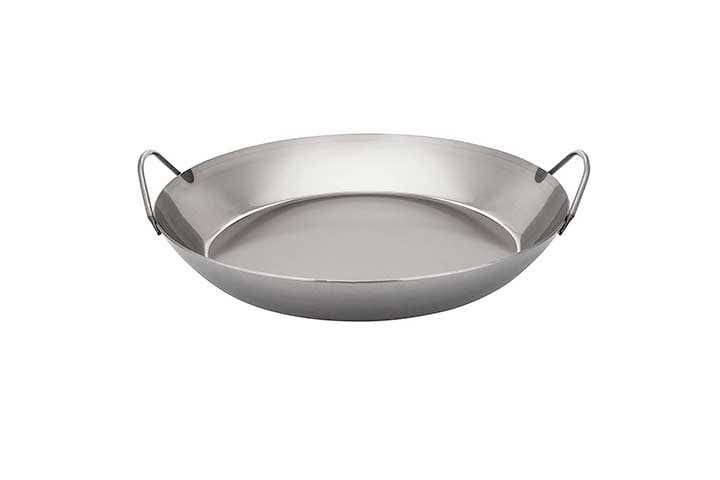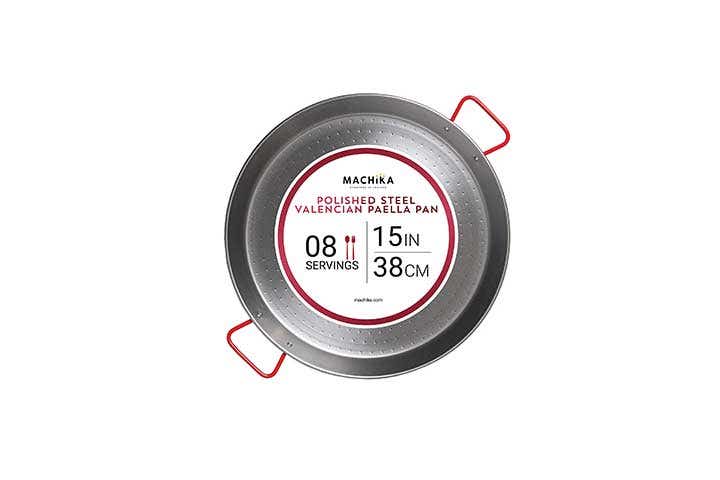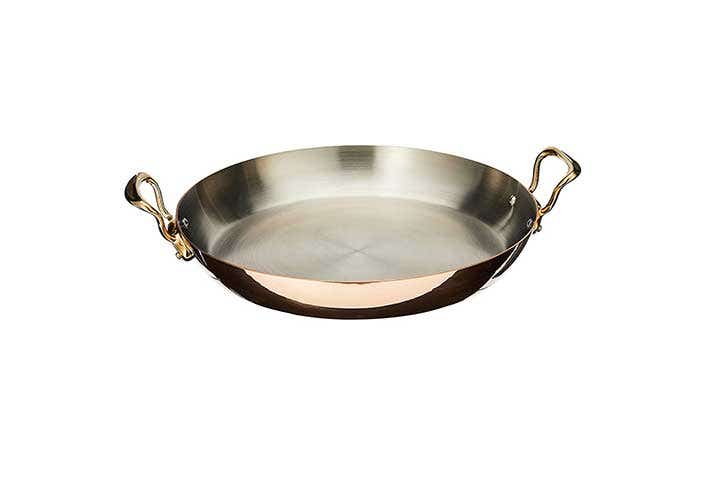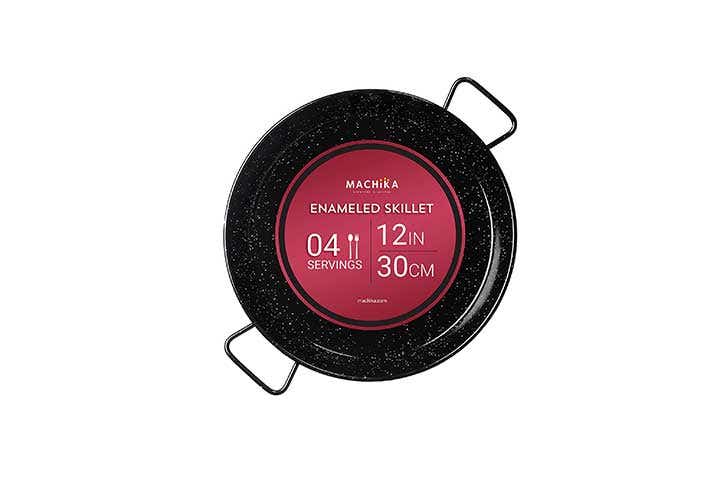Live Out Your Valencian Dreams With the Best Paella Pans
The saffron-scented dish really should be made in the right cookware.
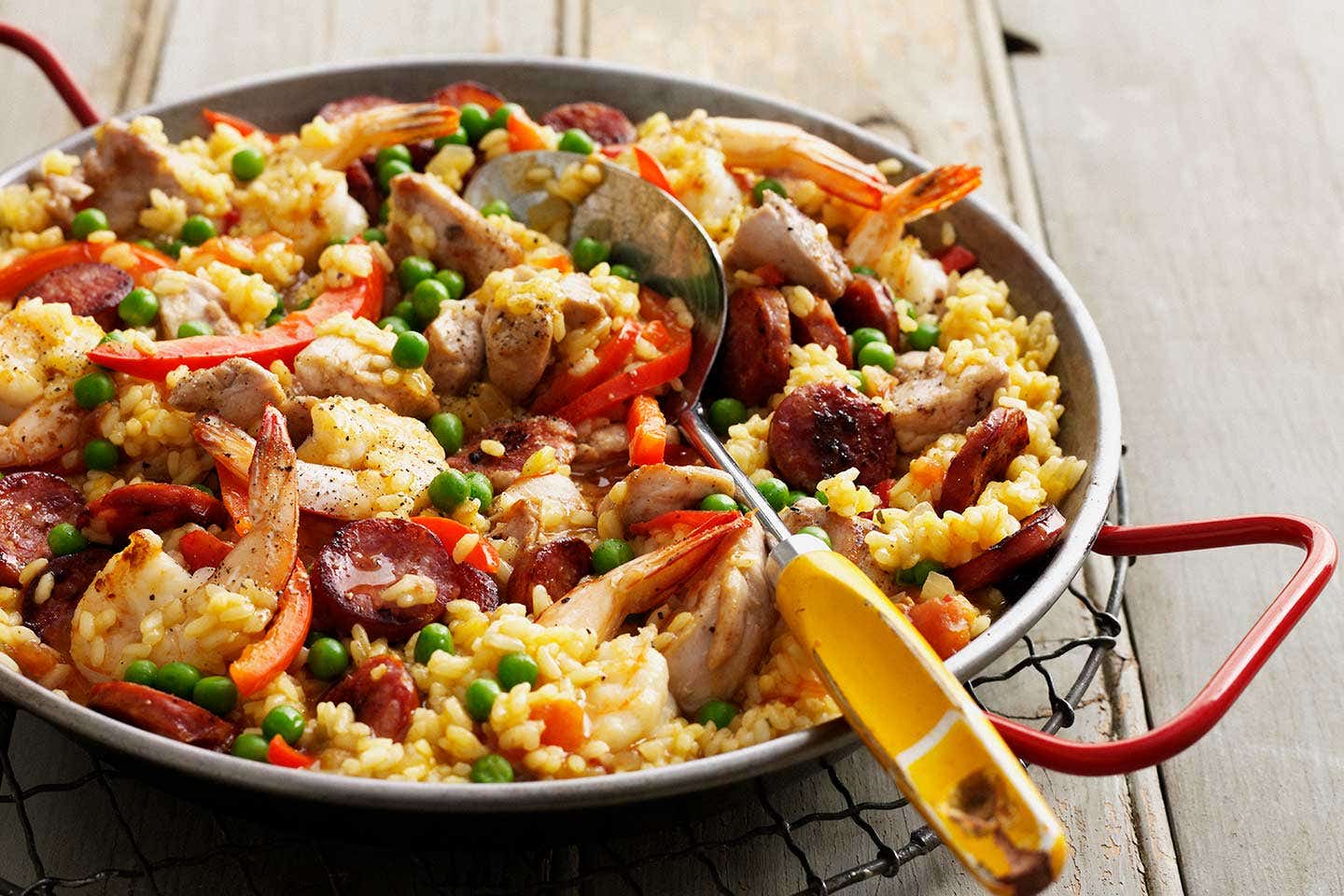
Testing these beautiful paella pans spoke to my Spanish ancestry in a big way, and brought back a flood of fragrant, saffron-scented memories. It was always the most special occasion as a kid: watching a relative dragging out the paella pan, blooming the saffron, scrubbing the mussels and clams, and taking the time to stand over the stove while moving the pan around so that the socarrat (the crust that forms on the rice in direct contact with the pan) would brown and crisp evenly.
As a disclaimer, I did test these pans out the traditional way (or as close to it as possible) on a charcoal grill, so while I have recommendations that are specific to that process, I also have recommendations for making paella on the stovetop. And yes, this article is going live in November, so yes, I was outside at the peak of New England autumn, working over a grill on the patio, and yes, the neighbors absolutely had questions for me.
For now, though, the only question I care about is, “What are the best paella pans out there?”
- Best Overall: Matfer Bourgeat Black Steel Paella Pan
- Best Value: Machika Polished Steel Valencian Paella Pan
- Best Upgrade: Mauviel M’Heritage Copper Paella Pan
- Best For Beginners: Machika Enameled Steel Paella Pan
Our Top Picks
Best Overall: Matfer Bourgeat Black Steel Paella Pan
Best Overall
Size: 15 ¾ inches | Material: Carbon Steel
Why we chose it: This heavy-duty pan heated the most evenly.
This thick-walled paella pan was a joy to use once I completed the seasoning process—it comes with detailed instructions on how to season before use, and it took under 30 minutes to complete. Once seasoned, this pan was beautifully nonstick, meaning that there was no digging or scraping required when serving paella, even when we got to that treasured socarrat.
Because the pan is so thick and heavy-duty, it did take a bit longer to preheat, but once it came to temperature, it retained heat very well. I didn’t even have to adjust the height of the pan during the cooking process. (This can be achieved with heat-proof bricks, or crumpled up aluminum foil.) One thing I particularly appreciated was the positioning of the handles: they’re pointed up at a vertical angle, rather than sticking out horizontally from the pan, which made it easier to grab and slide the pan around the grill without getting my hands too close to the flames. The pan’s seasoning made cleanup very simple. This pan comes in three sizes, 14 ⅛-inch, 15 ¾-inch, and 17 ¾-inch, all large enough to serve a crowd.
Best Value: Machika Polished Steel Valencian Paella Pan
Best Value
Size: 12 inches | Material: Carbon Steel
Why we chose it: This carbon-steel paella pan is a good value, at about $50 less than our Best Overall pick, but requires a bit more vigilance during cooking.
Like our Best Overall pick, this pan is made of carbon steel and must be seasoned before use. It is considerably thinner than the Matfer Bourgeat pan, so it heated up very quickly over the grill. This resulted in a faster cook time overall, but also meant that the pan had to be raised up a bit higher to keep the rice from burning. I did this with heat-proof bricks that I keep for use with my grill, but you can also use wadded up aluminum foil to achieve the same result. Clean-up was easy enough because of the seasoning. This pan comes in a big range of sizes, from 10 inches, serving two, up to 20 inches to serve up to 14 hungry paella fans.
Best Upgrade: Mauviel M’Heritage Copper Paella Pan
Best Upgrade
Size: 15.7 inches | Material: Copper
Why we chose it: This gorgeous copper pan with brass handles is all you need to make a show-stopping presentation of your paella.
Why, yes, I am recommending a pan that costs over five times more than our Best Overall pick because of its absolutely stunning aesthetics. But while stylish, this pan is much more than just a pretty face: it performed beautifully in my test and didn’t require any pre-seasoning. Putting this pan over a charcoal flame and watching as the copper bottom darkened felt like sacrilege, but the pan actually washes up pretty easily—especially if you keep Bar Keepers Friend around. This pan is made almost entirely of copper, except for the actual cooking surface, which is stainless steel. The socarrat was crispy golden brown and I found during cooking that I didn’t have to move this pan around the heat as much, which I suspect is because copper conducts heat a bit better than carbon steel.
Best For Beginners: Machika Enameled Steel Paella Pan
Best For Beginners
Size: 12 inches | Material: Enamel-coated Carbon Steel
Why we chose it: The enamel coating and relatively low price point make this a great option for folks just starting out on their paella journeys.
From the same manufacturer as our Best Value pick, this pan (and its polished steel cousin) is also great for folks wanting to make their paella indoors because it comes in a variety of oven-friendly sizes. The enamel coating means no seasoning is required beforehand, and it’s a breeze to clean up once you’ve packed yourselves full of paella. If you are cooking over a stove top, I recommend using a paella pan no larger than 12 inches and, if you’re cooking for more than four people, it’s better and easier to use two smaller pans at once rather than figure out how to maneuver a 20-inch pan over a single burner. It can be done, and there are methods for finishing paella in the oven, but trust me… two smaller pans is the way to go. Like the polished steel version from Machika, this pan is on the thinner side and heats quickly, so it requires a bit more vigilance during the cooking process, but this is otherwise a solid choice.
How We Chose These Products
We picked best-selling and highly rated pans from trusted brands to test. For the testing process, I followed the instructions from each manufacturer to prepare the pan before first use. In the case of the two carbon steel pans, I simply had to wash the pan, then follow detailed instructions for seasoning both pans. For the other two, they just needed to be washed and dried.
Once the pans were prepared, I cooked a batch of paella, scaling the recipe to fit the pan as needed over a charcoal grill. During the cooking process, I paid attention to how easy it was to maneuver the pan over the flame, how long it took to preheat the pan, and how well the pan seemed to retain heat as more and more ingredients were loaded in. Once the paella was ready to be served, I scooped the rice out, paying close attention to whether the socarrat was sticking to the pan.
When each pan had cooled, I washed each one according to the care instructions provided by the manufacturer, paying attention to how easily any stuck-on bits of rice came free, and whether any additional steps needed to be taken beyond just washing. The enamel-coated pan was the only one that could be washed and left to air-dry; the other three needed to be dried completely, and the two carbon steel pans needed to be oiled and heated after clean-up.
Features to Keep in Mind When Shopping for the Best Paella Pan
The Right Size This all depends on how many people you’re cooking for and what your intended heat source is. Pans larger than 12 or 14 inches should generally be used over a grill or some kind of open flame (or a burner built specifically for paella pans). A 10-inch pan can serve two, while a 20-inch pan can serve up to 14 people.
Heat Source Traditionally, paella is meant to be cooked over an open flame in a massive pan to serve a crowd. This can also be achieved over a gas or charcoal grill, but if you’re just cooking for a few people, you can use a smaller pan on your stovetop.
Construction A paella pan should be somewhat heavy-duty with thick walls to prevent your paella from burning. Some paella pans come with lids (none that we tested) but this is not necessary—paella is typically cooked uncovered.
Material Carbon steel seems to be the most common material for paella pans, but stainless steel and copper are good options, too. Carbon steel is the most ideal material because it retains heat well and tends to distribute it more evenly than most materials, with stainless steel being a close second, followed by copper.
Ask the Experts
Q: What is the best size for a paella pan?
It all depends on how many you’re cooking for and what your heat source is! 10-inch pans are good for two people, and can easily fit on a regular stovetop burner. Fifteen-inch pans are good for up to eight people, but should really be used over some kind of open flame, like a grill.
Q: Can I use a paella pan on a BBQ?
Yes— in fact, cooking over an open flame is the traditional method, so most paella pans should be able to handle it. When in doubt, though, check with the manufacturer’s instructions.
Q: Can I cook paella in a normal pan?
Definitely, especially if you’re planning on cooking on a stovetop and making a small amount for just a couple of people—you can use a 10- to 12-inch skillet as long as it’s wide and shallow, like a traditional paella pan. You’ll want something heavy duty, like carbon steel or stainless steel, and nothing too thin, otherwise you’ll risk burning the rice. A good paella pan is made with the paella cooking process in mind, including cooking over an open flame, so it’s best to go with the real deal.
Q: Should I season paella pans?
If it’s carbon steel, then the answer is usually yes, otherwise your rice will definitely stick. Even with seasoning, the socarrat in your paella may stick here and there in small spots, but it generally should lift out without much effort.
Q: Can paella pan go in the oven?
Generally, yes! This is a pretty common way to finish paella when cooking indoors for a more even cook. But, again, always check with your manufacturer if you’re not sure.
Our Take
The right paella pan for you all depends on whether you plan on making your paella traditionally, and how many people you plan on serving. You can use our Best Overall pick over a stovetop, but keep in mind that you’ll need to be moving the pan around near-constantly to keep the heat evenly distributed. It’s best to leave the larger pans for use on an open flame. The smaller Machika pans are better suited for stovetop use and, if you’re cooking for a big crowd, two 12-inch paella pans on separate burners should do the trick.
Keep Reading
Continue to Next Story
